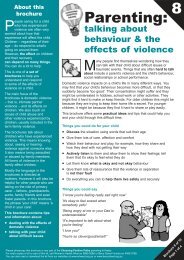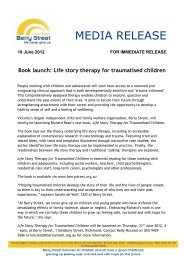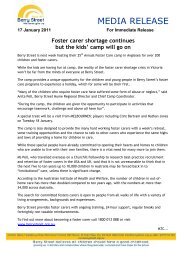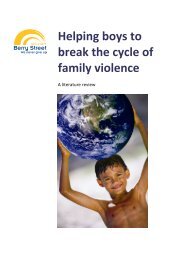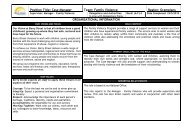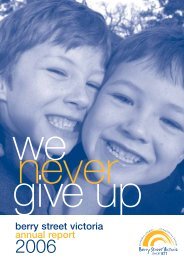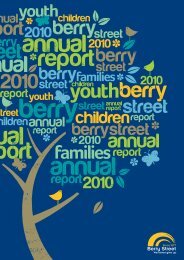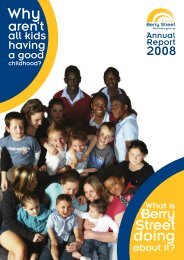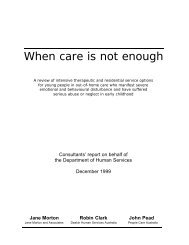Therapeutic foster care - Berry Street Childhood Institute
Therapeutic foster care - Berry Street Childhood Institute
Therapeutic foster care - Berry Street Childhood Institute
Create successful ePaper yourself
Turn your PDF publications into a flip-book with our unique Google optimized e-Paper software.
The child's network<br />
Children in <strong>care</strong> often have extensive professional<br />
networks created by the very nature of being in <strong>care</strong>.<br />
These networks may include <strong>foster</strong> <strong>care</strong>r, biological<br />
parents, child protection worker, <strong>foster</strong> <strong>care</strong> worker,<br />
clinician, cultural worker, school and professionals<br />
and other health professionals. Oppenheim (1992, ed.<br />
in Hill 1999, p. 203) states that, “The complex web of<br />
relationships surrounding <strong>foster</strong>ed children may be more<br />
helpfully conceived of as a network rather than a family<br />
system.” Such networks require <strong>care</strong>ful attention to<br />
the communication processes between members.<br />
Some authors have emphasised this by stating that<br />
communication within the network should be<br />
regarded as the “actual currency of interaction and is<br />
vital to the system” (Oppenheim, 1992, p. 204).<br />
While the intention of the network that supports the<br />
child in <strong>care</strong> is to work collaboratively with clear<br />
communication processes, the realities of achieving<br />
such outcomes are highly variable. A common<br />
element of contention within the network is the<br />
potential for confusion and misunderstanding about<br />
each other's role (Stott, 2006). It is these tensions that<br />
in turn hinder individuals within the network from<br />
working together in the best interests of the child.<br />
Stott (2006, ed. by Golding et al., 2006, p. 50) writes,<br />
“The danger in inter-agency forums is that there is a great<br />
potential to split professionals or agencies into good and<br />
bad, helpful or neglectful, rescuing or abandoning. This is<br />
a way of dealing with the heightened emotion of working<br />
with strong and opposing feelings towards the same child<br />
or birth parent or <strong>care</strong>r.” These powerful feelings that<br />
are evoked often create difficulties for networks<br />
striving to create a space to reflect and work together.<br />
It is therefore the collaboration and reflective space<br />
created by the network that is seen as essential in<br />
achieving good outcomes for children in <strong>care</strong>.<br />
A useful framework that describes the process of<br />
creating thinking networks for children in <strong>care</strong> is<br />
provided by Stott (2006, edited by Golding et al.,<br />
2006). Some services have even created a role of<br />
consultancy to the network. An example of this is a<br />
specialist consultation program in the U.K. that<br />
provides support to the child's whole <strong>care</strong>giving<br />
network (Golding, 2004). Golding argues that the<br />
child's network coming together is emphasised as<br />
being important in promoting understanding and to<br />
support working relationships (Golding, 2004). This<br />
process of consultation is thought to provide the<br />
“members of the network with time for reflection, which in<br />
itself can bring about change” (Golding, 2004).<br />
At times, defining and exploring the child's potential<br />
network can be problematic. Oppenheim (1992, ed.<br />
by Hill, 1999) suggests that the <strong>care</strong> team casts a<br />
wider net that is inclusive of extended family<br />
members and cultural links. In doing so, a greater<br />
resource for helping the child in <strong>care</strong> is created. At<br />
times “networks may have to be purposefully arranged”<br />
(Oppenheim, 1992, in Hill 1999, p. 210), in order to<br />
assist the children and their families. One potential<br />
model that purposefully seeks to create networks to<br />
benefit the child and their family (biological or <strong>foster</strong>)<br />
is the Mirror Families Concept (Brunner, 2006)<br />
described later in this review.<br />
One issue that appears to have received little<br />
attention in the literature to date is the notion of<br />
shared responsibility and equal partnership within<br />
the <strong>care</strong> network. In traditional <strong>foster</strong> <strong>care</strong> models the<br />
<strong>foster</strong> <strong>care</strong>rs are often relegated to a 'lesser position' in<br />
their ability to make decisions, this being most<br />
evidenced by failures to invite <strong>foster</strong> <strong>care</strong>rs to<br />
meetings, or neglecting to provide them with<br />
information about the child. In general, <strong>care</strong>rs have<br />
often deferred to professionals within the network to<br />
assist in making decisions in relation to the child. In<br />
contrast to these practices, therapeutic <strong>care</strong> models<br />
place an emphasis on <strong>care</strong>rs being an integral part of<br />
the treatment <strong>care</strong> team and 'equal partners' in<br />
treatment planning.<br />
Biological parent involvement in therapeutic<br />
<strong>foster</strong> <strong>care</strong><br />
Parents' involvement with their children in out of home<br />
<strong>care</strong> has historically been marred with difficulties.<br />
Some authors have attempted to explain this by noting<br />
the paradoxical dilemma that the child's source of<br />
'security' is also the child's source of danger and that it<br />
is this dilemma; that impacts on the 'system's' active<br />
engagement and involvement of parents. Jivanjee<br />
(1999a, p. 330) writes that, “Traditionally, the desire to<br />
protect children from abusive and/or neglectful parents<br />
contributed to limitations placed on their involvement when<br />
children were in <strong>foster</strong> <strong>care</strong>. [However,] Bowlby's (1969)<br />
seminal work on the importance of attachment relationships<br />
drew attention to the potential harm caused by parent-child<br />
separation when children are placed in <strong>foster</strong> <strong>care</strong>.”<br />
In Victoria, current practices which provide attention,<br />
support and inclusion to the biological family when<br />
children enter out of home <strong>care</strong> appear inconsistent.<br />
Carers within the Victorian <strong>care</strong> system have<br />
historically had little contact with biological families.<br />
In practice this has resulted in <strong>care</strong>rs both receiving<br />
little information about the child and the biological<br />
family, and rarely being included in supporting the<br />
child's contact with parents directly. A frequently<br />
utilised approach is that of the <strong>foster</strong> <strong>care</strong>r agency<br />
typically performing a “mediating role” between <strong>care</strong>r<br />
and parent. Such models of <strong>care</strong>r and parent<br />
separation are inconsistent with therapeutic <strong>care</strong><br />
approaches adopted internationally, which emphasise<br />
the <strong>care</strong>r's involvement with the biological family.<br />
Many authors have explored the importance of family<br />
continuity and involvement for children in TFC<br />
(Thomlison, 1991, Jivanjee, 1999a, Jivanjee, 1999b,<br />
Sanchirico & Jablonka, 2000). Biological family<br />
involvement is noted as being a critical element in<br />
providing therapeutic support to children in <strong>care</strong>.<br />
“Family involvement in children's treatment and <strong>care</strong> is<br />
likely to contribute to achieving the goal of long-term stable<br />
placements for children either with their families or in<br />
18 <strong>Therapeutic</strong> Foster Care





